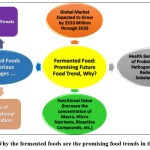Fermentation is a biotechnological process that exploits microbial metabolism to transform raw food matrices into complex foods or feeds. Many archaeological discoveries have shown that fermented food is one of the most important components of the human diet throughout history. Therefore, the role of fermented food is not limited to its nutritional importance only, but it extends to the fact that fermented food is considered an extraordinary ambassador in expressing different civilizations and cultures.1,2
One of the oldest food preservation techniques is fermentation, in which the food preservation strategy relies on the production of microbial metabolites that can counteract the growth and survival of undesirable microflora in food items.3 In recent decades, the fermentation process has witnessed a revolution in terms of technical development that it has not seen since its emergence thousands of years ago.
Of course, the first manufacturers of fermented foods did not have the knowledge and advantages of modern science related to the food industry. For example, enzymes and microorganisms were not discovered until about a century to two centuries ago, respectively. Recently, innovative applications of molecular techniques for analyzing and studying fermented foods have been explored.
People gradually have realized the nutritional and curative value of fermented foods and drinks, and this has increased in modern times with interest in probiotic microbes. Fermented food matrices such as pickles, fermented beverages, yogurt, fermented milk, cheese, fermented meats, etc. are the common vehicle in delivering probiotics, and probiotic delivery has been traditionally associated with these fermented foods that include alive fermentation microbes. It is known that there is a relentless pursuit and growing demand from consumers to discover more healthy foods, and this has crystallized in the past few years through the unveiling of fermented probiotic products by industrials and scientific researchers. The discovery of fermented probiotic products due to the historical roots of fermented foods across different eras and civilizations as healthy traditional foods served as extraordinary ambassadors as well-established marketing products around the world.4 In this context, the importance of benefiting from the modern technical revolution in the production of fermented probiotic foods came through the use of beneficial probiotics isolated from traditional fermented foods, and this of course reflected positively on enhancing the functional and therapeutic effects (especially when consumed regularly) in addition to improving the structural and organoleptic properties.1,5
Fermented foods are becoming a more significant recent food trend thanks to their nutritional values, health benefits, and economic revenues. The fermented food and drinks market is expected to grow by $533 million through 2026 at a CAGR of 7.34%.6
It should be noted that there are challenges facing fermented foods in the event that the fermentation process gets out of control, whether through legislators or through food manufacturers and then fermented foods become health threats.4 A notable example is the interactions between diet “fermented foods” and microbial infections that may increase the risk of certain cancers.7 Regarding the challenge of standardized international legislation, of the 400+ health claim applications made for probiotic and fermented foods, only one has been authorized by the European Commission. That claim relates to living cultures in yogurt improving lactose digestion in individuals who experience difficulty with digesting lactose. All other gut functions and immunity claims have been rejected because of insufficient scientific evidence.
Figure 1 shows, in a schematic way, why fermented foods are promising future food trends.
But an urgent inquiry comes to mind, despite the modern technological revolution in the field of food science and industry, there are more secrets in the fermentation mechanism that have not yet been revealed especially those related to the control of ferment microbes, fermenting agents, and fermenting conditions, etc. Hence, the future will carry to us a boom in product innovation, more global fermented food legislation, and omic technologies that will contribute to revealing unexplored open questions in the field of fermented food.
 |
Figure 1: Why the fermented foods are the promising food trends in the future ? Click here to view Figure |
References
- El Sheikha A.F., Revolution in Fermented Food: From Artisan Household Technology to Era of Biotechnology. In: Molecular Techniques in Food Biology: Safety, Biotechnology, Authenticity & Traceability. (Eds. A.F. El Sheikha, R.E. Levin, and J. Xu), John Wiley & Sons Ltd., Chichester, UK, pp. 241-260 (2018).
CrossRef - S. S. Behera, A. F. El Sheikha, R. Hammami, W. Kumar, Traditionally fermented pickles: How the microbial diversity associated with their nutritional and health benefits? J. Funct. Foods, 70, 103971 (2020). DOI: 10.1016/j.jff.2020.103971.
CrossRef - A. F. El Sheikha, D. M. Hu, Molecular techniques reveal more secrets of fermented foods. Crit. Rev. Food Sci. Nutr., 60 (1): 11-32 (2020). DOI: 10.1080/10408398.2018.1506906.
CrossRef - V. Capozzi, M. Fragasso, P. Russo, Microbiological safety and the management of microbial resources in artisanal foods and beverages: The need for a transdisciplinary assessment to conciliate actual trends and risks avoidance. Microorganisms, 8 (2), 306 (2020). DOI: 10.3390/microorganisms8020306.
CrossRef - K. M. G. M. M. Kariyawasam, N. -K. Lee, H. -D. Paik, Fermented dairy products as delivery vehicles of novel probiotic strains isolated from traditional fermented Asian foods. J. Food Sci. Technol., 58 (7), 2467–2478 (2021).
CrossRef - V. Campsi, What are the growth prospects for fermented foods? The Food Institute (2022), https://foodinstitute.com/focus/what-are-the-growth-prospects-for-fermented-foods/ (accessed 6 December 2022).
- N. K. Leeuwendaal, C. Stanton, P. W. O’Toole, T. P. Beresford, Fermented Foods, Health and the Gut Microbiome. Nutrients, 14 (7), 1527 (2022). DOI: 10.3390/nu14071527.
CrossRef

This work is licensed under a Creative Commons Attribution 4.0 International License.





